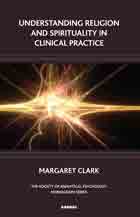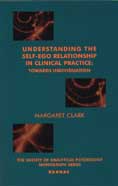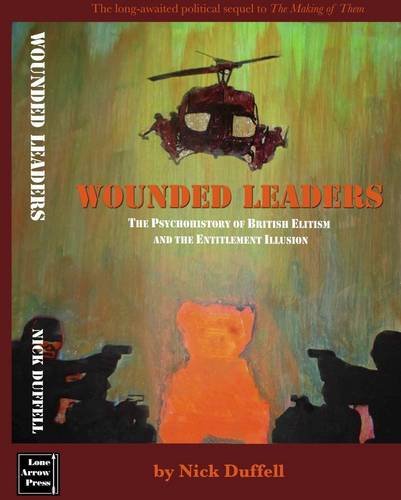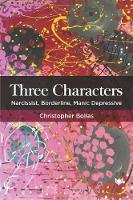Understanding Religion and Spirituality in Clinical Practice
Part of The Society of Analytical Psychology Monograph series - more in this series

Book Details
- Publisher : Routledge
- Published : 2012
- Cover : Paperback
- Pages : 118
- Category :
Jung and Analytical Psychology - Category 2 :
Individual Psychotherapy - Catalogue No : 29043
- ISBN 13 : 9781855758704
- ISBN 10 : 1855758709
Also by Margaret Clark
Our Customers Average Rating
Read all reviews (1)





Understanding Religion and Spirituality in Clinical Practice is a volume in the clinical practice monograph series from the Society of Analytical Psychology. This series is intended primarily for trainees on psychotherapy and psychodynamic counselling courses, and for those who are newly qualified.
Here, Margaret Clark considers the difficulties clinicians may encounter when patients talk about God or about their spiritual life, and how necessary it is for therapists to examine their own image of God and their own understanding of spirituality, so that they can distinguish these from those of their patients. She emphasizes how varied are people’s images and understanding of what “God” stands for, and how in healthy development these will change over time.
The book demonstrates, through numerous clinical vignettes, how clinicians can understand a patient’s talking about religion or about God – hearing the voice of God, having a vision of God, or being convinced that God wants them to act in a particular way; or, equally, seeing the Devil.
The book differentiates between religion and spirituality, and between religious and spiritual aims and practices. It also distinguishes some mystical and spiritual experiences from those which are considered psychotic.
There is reference to major theorists throughout, particularly to Freud, Jung, and Winnicott.
About the Author(s)
Margaret Clark trained as a psychodynamic counsellor and a psychoanalytic psychotherapist at WPF Therapy before she trained as a Jungian analyst at the Society of Analytical Psychology in London.
Customer Reviews
Our customers have given this title an average rating of 5 out of 5 from 1 review(s), add your own review for this title.
John Sargant on 07/08/2012 17:26:10




 (5 out of 5)
(5 out of 5)
When the work between a therapist and a patient enters the subjects of spirituality or religion, it may quickly go beyond the training that most therapists at present receive. Life in its physical, emotional and intellectual aspects may be thoroughly explored, but the spiritual may in contrast be avoided as an irrelevant hobby, or dismissed as a dangerous delusion.
This is one of a series of monographs produced primarily for trainees on psychotherapy and psychodynamic counselling courses. So it has many insights to offer in other counselling too. The author begins with a clear definition of spirituality and religion, and her reasons for using a capital G for God. In less than 100 pages, she writes to help therapists to deal with their patients' and their own experiences in these fields, rather than ignoring or avoiding them.
Whatever the bewildering range of religions, sects, cults and unbelief in society, the central theme is the image which each person has of God. Ch 3 explores the internal and external factors forming this image, which may be accepted or rejected, can change as life proceeds, and will be different from almost everyone else's image of God.
Chs 1, 2 and 4 relate this to the classical theorists, Freud and Jung, and to Winnicott of the later 20th century. Then chs 5, 6, 7 and 8 concentrate on evaluating spiritual and mystical experiences, again rooting these categories which are often used vaguely or misunderstood, in a wide range of other published approaches to the subject in ch 5, from Bion's "unknowable O" to Archbishop Williams on relating "the soul (whatever exactly that is)" to external realities of life.
The author writes with variety, too. From the pithy in talking about God ("same word, different meaning") to the expanding of abstract concepts like nature into vivid images "(blossom in spring-time, hills patchworked with cloud shadows, sea breakers roaring)".
In each short chapter, the author's aim of enabling us to understand is hugely helped by two or three "clinical vignettes". Each of these tells a story of the work done by a different therapist and patient, in two or three pages, in a wide range of situations. These scenes from real life, told anonymously, involve the reader in personal, emotional and yes, often spiritual experiences. Each vignette would repay study in a group. These chapters don't depend on expert knowledge of psychodynamic counselling, nor of world religions, but are packed with wise hints to help us increase our understanding. Any reader can then be more helpful "at the drop of a crisis", or in the longer term.
The last four chapters are each concerned with different aspects of spiritual experiences, from inspiration to addiction, seeing visions and hearing voices, being convinced that God demands a particular response, and encountering the Devil, or being possessed, with awareness of the borderline with psychosis and the need for other treatments. A variety of religious communities appear in the vignettes, and the interplay of family influences with the patient's image of God. For the therapist, and their supervisor, understanding the patient's concerns and experiences may also interact with what the therapist "believes or practises or despises or regrets or is tempted by or is awed by or dallies with in these spheres".
John Sargant, a friend of the author and retired parish priest.
A page to encourage other people to read the book, March 2012.
You may also like
Wounded Leaders: British Elitism and the Entitlement Illusion - A Psychohistory
Nick Duffell
Price £20.00
Trauma, Abandonment and Privilege: A Guide to Therapeutic Work with Boarding...
Nick Duffell
Price £35.99
Three Characters: Narcissist, Borderline, Manic Depressive
Christopher Bollas
Price £17.99
save £2.00








